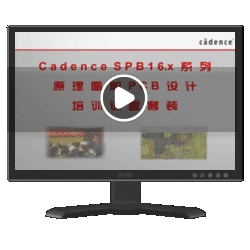- 易迪拓培训,专注于微波、射频、天线设计工程师的培养
Altium Designer高级视频教程Altium Designer Summer 08
淘宝出售
http://store.taobao.com/shop/view_shop.htm?asker=wangwang&shop_nick=lostboundary
教程为全英文视频教程1DVD光盘---400多个视频文件
本人从国外带回来的宝贝与大家分享
想要的可以索取样品视频
目录如下
Designing With an Innovation Staion
1. From Idea to Implementation
2. Altium Designer and the Innovation Station
3. Desktop NanoBoard Technical Overview
4. activate Altium Designer
5. FPGA Design for Board Level Designers
6. FPGA Design for Embedded Developers
7. create an FPGA design
8. decide which processor to use
9. Developing the application
10. use instruments in my FPGA design
11. build an FPGA design
12. debug my design
13. Exploring my deployment options
14. Building a complete Embedded FPGA application from scratch
The Altium Designer environment
1. edit individual design objects
2. edit text across multiple design objects
3. use the advanced selection features
4. edit multiple design objects with the Inspector
5. edit multiple design objects with the list panel
6. use design snippets
7. Where do I start
8. activate Altium Designer
9. Setup a License Server
10. customize toolbars, menus and shortcut keys
11. use panels to keep design information within easy reach
12. use multiple monitors
13. Where can I get help
Design Data Management
1. use Assembly Variants
2. go back to a previous version of my design
3. create a project and add documents to it
4. What are Special Strings
5. What is a project
6. link projects
7. import old designs
8. create a schematic template
9. standardize my design documents
10. use Altium Designer with a version control system
11. System preferences, project options or document settings
Design Capture
1. use queries to help me design
2. specify PCB routing widths during schematic capture
3. trace a signal across multiple schematic sheets
4. break a big design into subsheets
5. track down and resolve ERC errors
6. What's the best way for me to wire up my schematic
7. export a Smart PDF
8. create a Bill of Materials (BOM)
9. review and set PCB footprints in the Schematic Editor
10. enhance the appearance of my schematics
11. use and manage parameters
12. use differential pairs in my FPGA design
13. annotate my design
14. How can Smart Pasting increase my productivity
Designer Unification
1. cross probe between Schematic and PCB
2. keep my schematic and PCB files synchronized
3. link and sync my FPGA and PCB projects
4. resolve schematic to PCB synchronization problems
5. From Idea to Implementation
6. Altium Designer and the Innovation Station
7. Desktop NanoBoard Technical Overview
8. Developing the application
9. debug my design
10. Exploring my deployment options
Board Layout
1. create and manage polygons
2. route multiple traces
3. control pad shapes and holes?
4. set up track widths and clearances
5. find things on my PCB
6. configure the layer stackup and drill pairs
7. use dimensions on my PCB
8. track down and resolve DRC errors
9. ‘Keepout' components or copper from areas on my PCB
10. place components on top of each other without them interfering
11. interface to my MCAD system using STEP
12. confine components to a region on the PCB
13. use PCB Classes
14. position components in my PCB
15. route a connection on my PCB
16. generate manufacturing files
17. represent component bodies
18. measure between two points on my PCB
19. equalize net lengths
20. define the PCB shape
21. set the origin point on my PCB
22. run a design rule check on my PCB
23. define non-electrical design information on my PCB
24. set up the default printing behavior
25. include non-English characters in my design
26. set the PCB grid
27. What are all of the different PCB design objects
28. use FPGA Pin Swapping during PCB layout
Designer With FPGAs
1. create an FPGA design
2. target & constrain an FPGA design
3. build an FPGA design
4. use instruments in my FPGA design
5. setup and use the LAX instrument
6. decide which processor to use
7. use VHDL or Verilog in an FPGA design
8. create and share an FPGA Core
9. hook up the JTAG chains in my target system
10. choose an FPGA device
11. target FPGA specific resources
12. use the Frequency Counter instrument
13. use the Signal Generator instrument
14. use the Digital IO instrument
15. setup FPGA IO
16. include pre-generated EDIF in my FPGA design
17. What do I need to know about wishbone
18. add peripherals and IO to my microprocessor
19. use Altium Designer with a third party FPGA development board
20. transfer Xilinx Coregen IP to Altium Designer
21. transfer Altera MegaWizard Plugin Manager IP to Altium Designer
22. FPGA Design for Board Level Designers
23. FPGA Design for Embedded Developers
24. Building a complete Embedded FPGA application from scratch
Library and Componet Management
1. search for a component in the libraries
2. create a PCB Footprint
3. create a schematic symbol
4. verify and update footprints in the PCB editor
Embedded Intelligence
1. access wishbone peripherals in software
2. reformat the appearance of my source code
3. navigate around my source code
4. use the TSK51 microprocessor
5. use the TSK165 microprocessor
6. use the TSK80 microprocessor
7. use the TSK3000 microprocessor
啥宝贝都是官方教程,还不如买郭天祥的视频教程.
建议小编给删除了
不错,顶一下!感谢小编!

